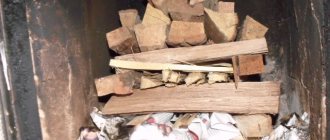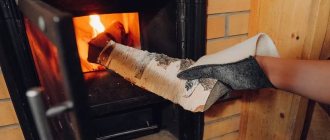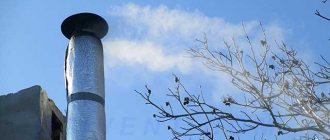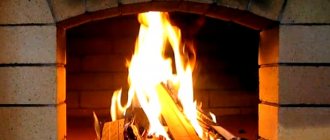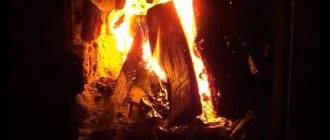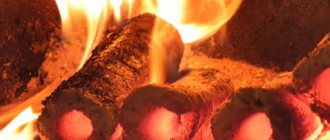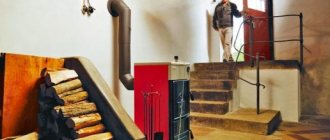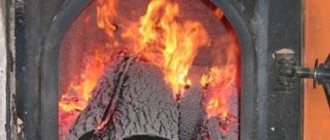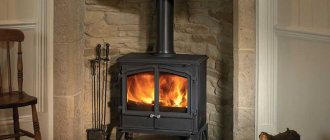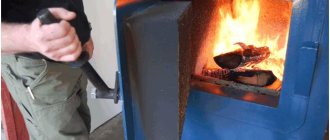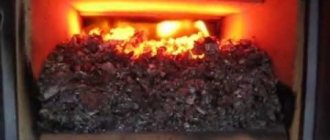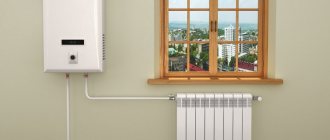From time to time we are faced with a situation when we only have raw firewood at our disposal, but it is necessary to light a stove or light a fire. What should be done in such a situation, how to light raw wood in a stove, how to make a normal fire from such raw materials, let's figure it out together.
Real live fire in the oven
What kind of wood should not be used to heat a stove?
Ideally, firewood should burn for a long time, produce a lot of heat, and a minimum of smoke and waste. But in practice, you will have to find a compromise, which will be easier if you follow the rules. So, you cannot heat the stove with freshly cut wood. It will burn sluggishly and smoke heavily (due to the large amount of moisture).
Interesting materials:
What does Rise and Shine mean? What does anti-hair growth mean? What does percentage mean in computer science? What does it mean to check MD5? What does verification code mean? What does it mean to live life to the fullest according to the story of a living flame? What does durum wheat mean? What does PTS mean in a measuring cup? What does it mean to start rumors? What does hollow chain mean?
Step-by-step instruction
Sooner or later, each of us faces the problem of wet firewood, and the situations can be very different. For example, when you need to light a fire in nature to keep warm, cook fish soup, shish kebab, baked potatoes, or when you need to heat the house, prepare a bathhouse to steam and wash. It is much more difficult to light wet firewood, but with the right approach this task can be easily accomplished. Let's consider at the same time how to heat a stove with raw wood and how to light a fire with it in nature.
To implement a simple plan for lighting firewood, we will need:
- a good ax, a sharp knife;
- wet firewood;
- fine salt;
- a stack of ordinary newspapers;
- lighter or matches.
First of all, we need to chop some of the firewood into small pieces, chips. Small pieces of wood will quickly dry out and catch fire, while large logs, on the contrary, will negatively affect our fire. A good ax and a sharp knife will allow you to do the work quickly.
Winter version of a small fire
Note that the firewood inside may well be dry, so we make chips and splinters from the middle part of the logs. If we are dealing with birch firewood, then we remove the birch bark from the blanks. On logs, birch bark will not immediately dry out and catch fire, but separately, on the contrary, it will easily ignite and give the necessary fire.
We assemble a small hut from the resulting wood chips, put small splinters in the base, and cover them with larger wood chips. It is important that there is room for air inside, as well as that air masses circulate freely inside and outside our structure.
We build the hut on a pedestal of newspapers, additionally covering the chips on all sides with newspapers. When placing newspapers inside, you should crumple them and give them some volume. If there is birch bark, also lay it deep in the hut. Sprinkle fine salt on top of the structure. Being a good adsorbent, salt will draw out some of the moisture from the wood chips.
Carrying out preparatory activities before lighting the fire
Note that in a brick-lined stove it is very easy to assemble such a structure and light it. At least it’s more convenient and better to light such a stove than to work with a shapeless gray hole. For many stove owners, the memories of the difficulties they overcame during the construction stage, when they erected the stove, covered it with bricks, and covered it, are still fresh. All the efforts of that time were not in vain; now you can quickly and easily light a fire in the firebox, even from damp wood.
Good to know: Chainsaw for harvesting firewood, how to choose the optimal machine
The preparatory measures have been completed, it’s time to set fire to our original structure. At the same time, try to pay attention to whether the wet wood-burning hut made of wood chips will catch fire from the newspapers. If you fail to light the fire the first time, you should repeat the procedure. In this case, the dried wood chips will flare up better. If the fire catches on, it’s time to put in a couple of larger logs. This should be done so as not to block the access of air to the fire.
If we are dealing with a stove, then after receiving fire, we should open the hood and close the doors to the room itself. When lighting a fire in nature, you can blow it a little, using any suitable object as a fan. For the first half hour, you should maintain the fire using only thin chips and logs.
When the fire becomes more confident, you can add more wood. Try not to push too much, clutter the flame, or block the air (oxygen) access to the fire. Large logs can only be laid when you already have a sufficient amount of good coals. If you had to heat the stove with raw wood, then monitor the intensity of the fire, do not let it weaken too much, because if there is not enough heat for new raw logs, then everything may simply go out. Starting a fire requires patience, especially when you are dealing with raw fuel.
Decorative elements accompanying the stove
In order not to think about whether it is possible to heat the stove with raw wood, do the preparatory work, bring some firewood home and dry it near the stove for the future. Dry firewood stacked near the stove and ready for use will allow you not to think about such problems in the future. In addition, a stack of firewood can make a very original decorative item for the home.
Good to know: How to make a firewood rack for firewood outdoors and at home with your own hands
Safety regulations
The main hazards when using furnaces are carbon monoxide and fire. For safety reasons, follow a few rules:
- inspect the stove before lighting for traces of soot;
- do not use flammable liquids for ignition;
- finish heating 2 hours before bedtime;
- Use fuel that is suitable for this type of stove.
In conclusion, we note that brick stoves are heated to the maximum, and metal stoves - in small portions to avoid warping of the body.
Eurowood manufacturing technology
Industrial method
The process of producing fuel cells from waste from the wood processing industry is simple and straightforward. Sawdust from oak, linden, and pine are used as raw materials. High-quality bricks are made from birch dust, very good heat dissipation. The European firewood production line consists of the following units:
- crusher;
- Dryer;
- press.
To increase production output and reduce physical labor at a plant for the production of fuel briquettes, the following should be used:
- magnets for extracting metal particles;
- vibration sorter;
- belt or pipe feeding material into the dryer;
- hopper for raw materials, with dispenser and agitator;
- packaging machine for finished products.
Briquette production line
At the first stage, the raw materials are cleaned from impurities, metal particles are removed from the belt using magnets, and a sorter sifts the material. Next, the sawdust is sent to a crusher, where it is crushed to a homogeneous mass. The line feeds sawdust into the dryer, where the moisture content of the mass drops to 8–10%, and from there it enters the hopper via an auger. Here the prepared raw materials are fed to an industrial molding press, from the depths of which the finished product emerges; at the end of the line there is a device for packaging finished products. During the pressing process, lignin is released from wood; this occurs only at high pressure and high temperature. When heated to several hundred degrees, the outer side of the fuel blocks is slightly charred, which is an indicator of a quality product. The following types of presses are used in production to create fuel blocks:
- hydraulic;
- screw
Hydraulic presses develop a force in the range of 300–600 bar. Pressed sawdust for heating comes out in the form of bricks. An auger is a pipe within which a screw shaft rotates, moving the raw material forward. The channel through which the wood pulp flows narrows, and thus compression occurs. The sawdust screw press reaches a pressure of 1000 bar. The output is fuel cells in the form of a hexagon. This method of creating fuel cells is called extrusion.
Subtleties and nuances
There are some secrets to successfully making fire from wet wood that we would also like to share:
- The worst thing is if you have damp aspen firewood. This type of wood produces a small amount of heat, so aspen firewood will be very difficult to light. The logs will slowly smolder when exposed to temperature, releasing very little heat.
- A good option for quickly kindling raw logs is birch or spruce. Despite the fact that these tree species emit a lot of soot and soot when burned, they are optimal for quick kindling. The fire catches on the chips and birch bark in literally a matter of seconds.
Wet firewood prepared for splitting
- An original way to quickly dry wood was invented by our ancestors. Salt should be poured in large quantities onto wet firewood. The salt will draw out some of the moisture, and the firewood will become usable.
- If we light a fire in nature and we have flammable liquids in our arsenal, for example, diesel fuel, gasoline, kerosene, then it is quite possible to pour these compounds on the wood chips. If we want to use flammable liquids in the stove, we can moisten a rag with them and place it between the logs. The characteristic odor from such liquids will disappear fairly quickly after lighting a fire.
- Some experts recommend putting an empty bottle of vegetable oil in the firebox. With its help you can quickly get the required amount of fire.
Please note that firewood is always purchased raw. It is best to do this in winter, stocking up for the next season, when equipment easily enters the forest. In this case, you will have the firewood for a whole year before using it. They must be stored in a woodpile, protected from precipitation and blown by the wind.
As you can see, there are no particular difficulties with kindling raw firewood; the main thing is to approach this issue thoughtfully and carry out the preparatory work efficiently. With a little patience, you will have a nice, intense fire that provides warmth.
Features of the furnace fire in the black sauna
Lighting a stove the black way is sometimes practiced today when heating a bathhouse, since this method produces more efficiency than the “white” method, and less fuel is consumed.
Combustion products in such devices do not exit through the chimney, but through the windows and door. A large amount of soot settles on the walls, acting as an adsorbent.
The procedure for firing a black stove in a bathhouse:
- Open the windows and door to bring in fresh air and support the combustion process.
- Fold the firewood into a “house” by placing paper under it and set it on fire.
- Before adding wood for the second time, generously spray the walls and shelves with water.
- Gradually add firewood, finishing the fire when crimson light appears above the stones.
- Wait until the last portion of wood burns out and remove the coals.
- Ventilate the room by opening the windows and door.
- Rinse doors and shelves with cold water.
- Splash a tub of water on the heater and close the doors.
Now you can enjoy all the delights of a steam room, melted in black!
Key points when working with wood
Do not remove or turn the protective cover away from you. This is the main rule. It prevents cutting wheel fragments from hitting nearby people. Otherwise, injuries cannot be avoided. You should also remember:
- Before starting work, make sure that the protective cover is tightly fastened;
- check the integrity of the disk: the presence of chips and cracks makes them unsuitable for use;
- hold the angle grinder with the casing facing the operator;
- before work, check at different speeds - there should be no vibration;
- before cutting, check the tree for knots;
- hold the grinder firmly while cutting;
- periodically check the disk by stopping work;
- take a comfortable and stable body position;
- If jammed, turn off the grinder immediately.
You are only allowed to move around the room with the device turned off. You should not risk your health and the well-being of others. When cutting, do not press the angle grinder with great force: the cutting occurs naturally.
How to quickly dry firewood
If you did not take care of the preparation of logs in advance, and you need to heat the constructed structure right now, then you can get out of the situation:
- The raw material is sawn and split to the size needed for your system.
- We stack the finished dies next to or above the heating structure so that air easily circulates between them (a well or a thin layer).
- Please remember that the drying material may ignite! Therefore, safety precautions must be observed. Direct contact with very hot parts of the heating device must not be allowed. A tree can catch fire even at a distance from infrared radiation!
- Such actions will allow you to quickly solve the ignition problem.
- Logs, without direct contact with precipitation, dry in wet autumn and severe frosts. The conclusion from this is to store logs indoors.
- Soft woods such as pine, spruce, aspen, and poplar are most suitable for ignition. It must be kept in mind that they burn very poorly when wet. But they are easier to dry than oak, ash or birch.
How to speed up kindling
Many hunters give advice on how to quickly dry firewood. They saved more than one frozen life in extreme conditions. There are prepared woodpiles in the parking lots, only in the open air, where rain falls on them. Accordingly, during winter, they freeze and become covered with ice. But this does not prevent hunters from warming up. They use several old folk techniques:
- It is necessary to clear the lumber of snow.
- Chop into small slivers.
- Melt the unit, as we wrote earlier.
- Just throw two handfuls of coarse table salt onto the paper. It will absorb excess moisture.
- If you don’t have a newspaper at hand, take a piece of plastic or roofing felt. You will spend a little more time lighting these items.
- If this is not the case, then vegetable oil will help you. You can pour a tablespoon onto the wood chips. Or fill a liquid bottle with sawdust, shavings, newspaper or dry rags. And also put it in the fire.
- Use diesel fuel and gasoline. But there is no need to splash them into the combustion chamber. You need to soak a piece of rag in the liquid and place it next to the wood chips. Then you will avoid a fire hazard.
Of course, you can suffer for a long time with an old heater or stove, but in the end you will achieve results. But will it give you all the heat, will it be reliable in operation, will it withstand the load of wet wood? Before building a house with stove heating, you should contact specialized stores for advice.
Checking traction
The mechanism of operation of the smoke channel and the blower, as a rule, remains hidden from view, so its effectiveness is sometimes ignored. Moreover, even if the channel is opened, there is no guarantee that it fully meets the oxygen needs of the hearth. This system is clearly visible in cast iron and steel structures. The question of how to properly heat a metal stove from the point of view of sufficient supply of air masses comes down to assessing the brightness of the flame. An experienced stoker determines the adequacy of the oxygen supply by the color of the fire. So, white color indicates that the channel is open too much, and the valve should be closed a little. Conversely, a bright yellow tint indicates that the lesion is receiving a normal flow of oxygen.
Types of wood by moisture level
It happens that the firewood is damp or simply not there, and the house needs to be warmed up. Then freshly cut trees are used. It is better if it is birch or aspen. Oak may also work, but it will be difficult to split. The speed and quality of kindling depends on the moisture content of the firewood.
Wood is divided into a number of categories based on moisture level:
- 0% - completely dry. It is rare due to the natural humidity of the air indoors or outdoors.
- From 7 to 20%. This importance can be achieved by drying the tree in a special chamber or by keeping it in a warm house all winter.
- 20 -45%, normally dried wood from a woodpile.
- 45-80% is fresh firewood, just cut. Winter and autumn firewood will be more moist. It is difficult to heat with them; you need to follow the kindling technology.
- Wood that has been in water for a long time has more than 80% humidity. It is generally impossible to drown like this.
If you have glass smoking near the stove door...
In any oven there are times when glass smokes. This often happens during kindling, when the stove is still cold or the air lock has not been “broken.” The combustion temperature is not yet high, and there is a lot, a lot of unburnt gases, smoke, which does not have time to escape and can swirl around the glass of the door.
Glass blowing measures do not always help, although we try to make fireboxes with glass ventilation. It may be trivial to have damp firewood (among other things).
What to do in such a situation?
Just try for the first 15-30 minutes of the fire, while the wood is burning, open the fire door 0.5-1 centimeter, this is enough to cut off the smoke from the glass. This will also provide additional oxygen for lighting the stove. With this calculation, you can open the blower a little less.
What is order
What is order and why is it needed? This is a detailed diagram according to which the furnace is laid; without it, work cannot begin. Even experienced stove makers first draw up an arrangement plan, and then begin laying. This order indicates the location of the bricks for each individual row, their sizes, places for installing doors, fireboxes and other grates.
An example of the arrangement of a brick stove.
The laying of stoves can be carried out using various methods, for example, undercut or with empty seams. If the first method is used, then after completion of the work the surface of the stove is not plastered, since the solution has already filled all the seams. Laying can be done in one brick, in ¾, in ½ - it all depends on the size and appearance of the structure.
The masonry rules provide for the use of only special oven bricks. The use of slotted, silicate, conventional fireproof, expanded clay is not allowed under any circumstances. The first row must be laid out dry, that is, no solution is used. It is necessary to clearly determine the direction of the future masonry; if necessary, the brick can be easily repositioned. At the same time, the position of each door and front wall is determined. The second row is laid out with mortar, followed by laying the corners of the future fireplace or stove. During work, plumb lines and string must be used so that the wall goes vertically upward and does not have displacements or deviations. The masonry rules are the same for any structure. The ash pit, firebox, and ash pit may be located in different places, but their fastening and reinforcement remains the same.
This masonry begins after the second row above the firebox of the future furnace. When laying the cladding, you must remember that a rigid connection between it and the stove cannot be made, since the temperature characteristics will be completely different and cracking is possible. When laying a chimney begins, you must remember to install a special valve; it must be smoothly and well regulated.
Reloading
Long-burning solid fuel devices are designed in such a way that one fill lasts for a long time. With regular wood-burning stoves, one serving doesn't last long. At best, not 6-8 hours. Therefore, to maintain the operating mode, it is necessary to re-bookmark. It is performed when the wood is almost burnt out, but a bluish light flame remains.
In the process of laying a new portion, two important conditions are met. First, carbon monoxide must not be allowed to enter the room. Secondly, you need to keep the temperature high, which will make re-kindling much easier. Therefore, they do everything as quickly as possible. They begin by carefully raking the smoldering remains of firewood and coals into the center of the chamber. So that they are in the middle of the new bookmark. Then everything is done the same way as the first time.
